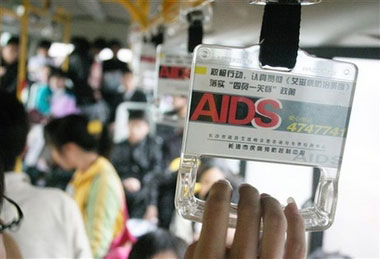HIV/AIDS cases grow 30% in China
By Zhang Feng (China Daily)Updated: 2006-11-22 07:53
The reported number of HIV/AIDS cases in China has grown by nearly 30 per cent this year compared with last year, according to figures released yesterday by the Ministry of Health.
Health officials attributed many of the new cases to better reporting of existing cases, though they also warned that the virus seemed to be spreading from high-risk groups to the general public.
Experts from the United Nations and the Ministry of Health estimate that some 650,000 people in China carried HIV at the end of December 2005, suggesting that many people were unaware that they carry the virus.
As of October 31, 12,464 people have died in China as a result of illnesses associated with the HIV virus, Hao Yang, deputy director of the Ministry of Health's Disease Control Bureau, said yesterday.
Hao added that virus appeared to be spreading from so-called high-risk groups to the general public.
Drug abuse accounted for 37 per cent of the cases reported in the first 10 months of the year, while unsafe sexual contact had caused 28 per cent, Hao noted, adding that these two activities had caused most of the infections. Before 2002, only 10 per cent of all infections were caused by sexual contact.
Ministry officials who have been observing monitoring sites around the country have found that the percentage of sex workers infected by HIV/AIDS had grown to 1 per cent last year, compared with only 0.02 per cent in 1996.
HIV testing has found that the infection rate among pregnant women in provinces that are experiencing serious epidemics, such as Southwest China's Yunnan Province, is about 1 per cent. Such statistics are the clearest evidence that the virus is spreading from high-risk groups to the general public as a result of unsafe sexual contact and drug abuse.
Hao said these two causes posed a great danger because effective measures to dissuade unsafe behaviour are not yet in place.
For example, according to an investigation by public health workers, only 38 per cent of prostitutes in certain areas insisted on using condoms during intercourse. And about half of the drug abusers surveyed still share syringes while taking intravenous drugs, Hao said.
Sexual activity among gay men is also an important source of new HIV/AIDS infections. Statistics show that in some areas the infection rate among gay men is between 1 and 4 per cent.
Government officials have launched a concerted effort to prevent and control HIV/AIDS in recent years. It has greatly enhanced HIV testing and monitoring among both high-risk groups and the general public, which has helped public health workers identify more cases.
For example, the provincial government of Central China's Henan launched a wide-ranging investigation of people who sold blood in 1990s and found more than 30,000 carriers, the majority of which had been infected by contaminated blood. Farmers from many regions, especailly in Henan, Shanxi and Anhui, sold blood in the 1990s to earn extra money.
Among the total reported cases this year, 5.1 per cent were caused by people selling blood illegally or receiving infected blood from hospitals.
The central government also offers free HIV testing, free anti-virus treatment and free education for the children of people with HIV/AIDS. Some 28,757 people in 31 provinces and regions received free anti-viral treatment. By the end of this year, the number will reach to 30,000.
|
||
|
||
|
|


